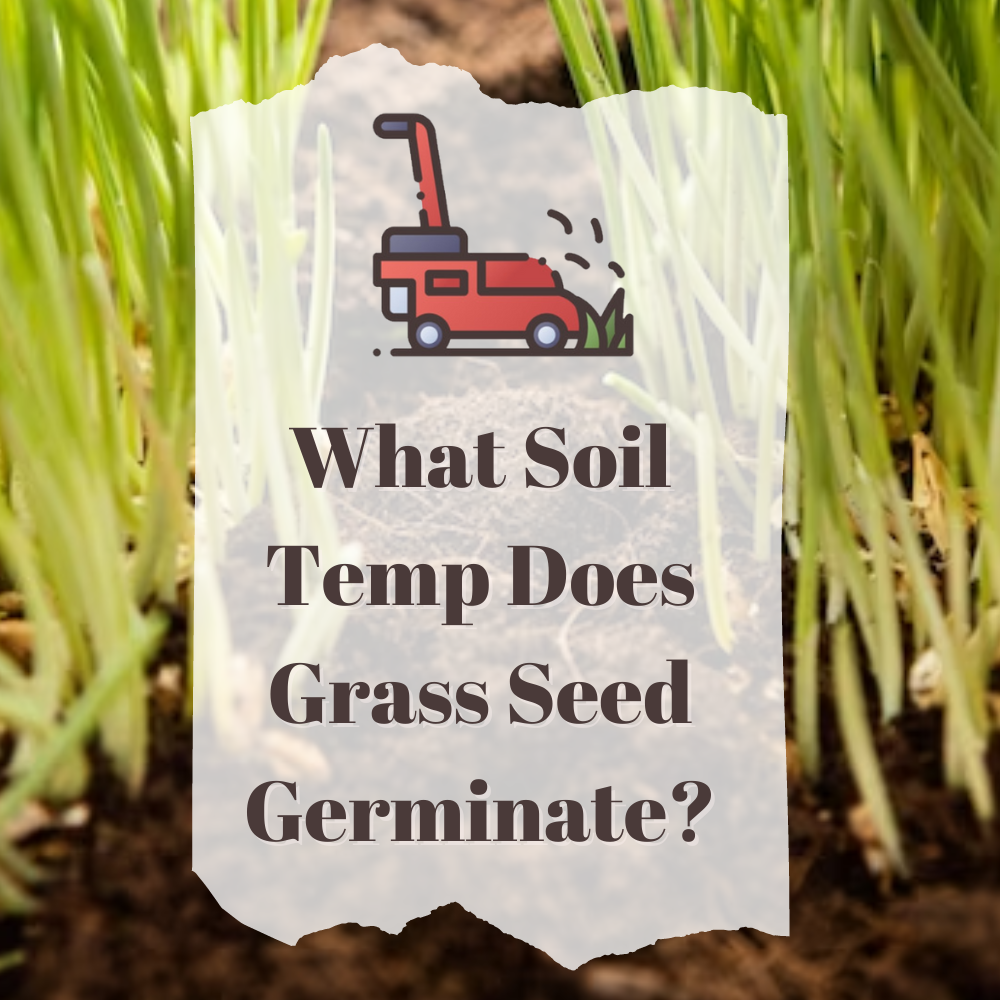
As someone who takes pride in maintaining a lush, green lawn, I understand the importance of starting with the right foundation: grass seed germination. One crucial factor that often goes overlooked is soil temperature. As I’ve learned through my own trial and error, planting grass seed at the wrong temperature can result in poor germination rates or even total failure.
In this article, I’ll provide a detailed analysis of the ideal soil temperature ranges for different types of grasses to help you achieve the best possible results for your lawn.
I’ll also share tips for measuring and achieving the right soil temperature, as well as common mistakes to avoid. Whether you’re a seasoned lawn care veteran or a beginner looking to establish a new lawn, understanding the role of soil temperature in grass seed germination is key to achieving a healthy, vibrant lawn.
Understanding the Importance of Soil Temperature for Grass Seed Germination
Want your lawn to grow? It’s all about understanding the right temperature for those tiny sprouts to pop up! Soil temperature plays a crucial role in the germination of grass seeds.
As a gardener or landscaper, it’s essential to know the ideal soil temperature to ensure successful grass seed germination. Different types of grass have different temperature requirements for germination.
For instance, cool-season grasses, such as Kentucky bluegrass and fine fescue, generally need a soil temperature range of 50°F to 65°F for optimal germination. On the other hand, warm-season grasses, such as Bermuda grass and Zoysia grass, require higher soil temperatures ranging from 75°F to 85°F.
It’s also essential to note that soil temperature can vary depending on the time of the year, location, and soil type. Therefore, it’s crucial to measure the soil temperature regularly using a soil thermometer to ensure that the soil remains within the ideal range for the grass seed to germinate.
Different Types of Grass and Their Ideal Soil Temperature Ranges
Let’s explore the best temperature range for different types of grass to sprout and grow strong.
Each type of grass has its own ideal soil temperature range. For example, cool-season grasses like Kentucky bluegrass, fescue, and ryegrass prefer a soil temperature range of 50 to 65°F for optimal germination.
In contrast, warm-season grasses like Bermuda grass, Zoysia grass, and St. Augustine grass thrive in warmer soil temperatures of 65 to 80°F.
It’s important to note that if the soil temperature is too cold or too hot, the grass seed may fail to germinate or may take longer to sprout. Therefore, it’s crucial to monitor the soil temperature before planting the grass seed.
A soil thermometer can be used to measure the soil temperature at a depth of two to three inches. By understanding the ideal soil temperature range for different types of grass, you can ensure a successful and healthy lawn.

Warm-Season Grasses and Their Soil Temperature Requirements
If you’re planning to grow warm-season grasses like Bermuda grass, Zoysia grass, or St. Augustine grass, you’ll want to know their ideal temperature range for sprouting and thriving.
Warm-season grasses are typically planted in late spring or early summer when soil temperatures are between 65-70°F. These grasses require warm soil temperatures to germinate and grow, and they thrive in temperatures between 80-95°F.
Bermuda grass, for example, requires soil temperatures of at least 65°F to germinate, with optimal temperatures between 75-85°F. Zoysia grass has a slightly higher minimum temperature of 70°F, but prefers soil temperatures between 80-85°F.
St. Augustine grass is the most sensitive to soil temperature, requiring a minimum of 70°F and an optimal range of 80-95°F.
By understanding the ideal temperature ranges for these warm-season grasses, you can ensure successful germination and growth of your lawn.
Cool-Season Grasses and Their Soil Temperature Requirements
You might be wondering what temperatures are best for growing cool-season grasses like Kentucky bluegrass, fescue, or ryegrass in your lawn.
Well, the ideal soil temperature for cool-season grasses to germinate is between 50 and 65 degrees Fahrenheit. This means that the best time to plant cool-season grasses is during the cooler months of fall or early spring when the soil is still warm enough for the seeds to germinate.
It’s important to note that if the soil temperature is too high or too low, the cool-season grass seeds may fail to germinate or grow properly.
For example, if the soil temperature is above 75 degrees Fahrenheit, the seeds may become dormant and not germinate at all. On the other hand, if the soil temperature is below 40 degrees Fahrenheit, the seeds may not have enough energy to sprout.
Therefore, it’s important to monitor the soil temperature to ensure optimal growing conditions for your cool-season grasses.
How to Measure Soil Temperature for Grass Seed Germination
Measuring the temperature of your lawn’s soil is crucial for successful growth of cool-season grasses. Before planting grass seeds, it’s important to know the ideal soil temperature for germination.
The ideal soil temperature for cool-season grasses such as Kentucky bluegrass, tall fescue, and perennial ryegrass is between 50-65°F. If the soil temperature is too low, the seeds won’t germinate, and if it’s too high, the seeds may not establish properly.
To measure the soil temperature, you can use a soil thermometer. Insert the thermometer into the soil at a depth of 2-4 inches, which is the depth at which most grass seeds are planted. Take multiple readings at different locations in your lawn to get an accurate average temperature.
It’s important to measure the soil temperature at the same time each day, as soil temperature can fluctuate throughout the day. Once you’ve determined the soil temperature, you can decide when to plant your grass seeds for optimal germination.
By measuring the soil temperature, you can ensure that your grass seeds have the best chance of germinating and establishing a healthy lawn.
Tips for Achieving the Right Soil Temperature for Your Lawn
Achieving the ideal temperature for your lawn’s growth requires careful consideration of factors such as location, time of year, and weather patterns.
Generally, grass seed germinates best when soil temperatures reach around 60-75°F. However, different types of grass have different temperature requirements for germination.
For example, warm-season grasses such as Bermuda grass and Zoysia grass require higher soil temperatures than cool-season grasses like Kentucky bluegrass and fescue.
To achieve the right soil temperature for your lawn, it’s important to pay close attention to the weather forecast and to plant your grass seed during the optimal time of year.
In addition, using a soil thermometer to measure the soil temperature can help ensure that you’re planting at the right time.
If the soil temperature is too low, you can warm up the soil by covering it with clear plastic for a few days. Conversely, if the temperature is too high, you can help cool the soil by watering it frequently.
By taking these steps, you can optimize the conditions for your grass seed to germinate and grow into a lush, healthy lawn.

Common Mistakes to Avoid When Planting Grass Seed
Planting a beautiful and healthy lawn can be challenging, but avoiding common mistakes is key to success.
One of the most common mistakes people make when planting grass seed is not paying attention to soil temperature. It’s important to remember that different grass species have different requirements when it comes to soil temperature for germination. For example, cool-season grasses like Kentucky bluegrass, perennial ryegrass, and tall fescue require soil temperatures between 50 and 65 degrees Fahrenheit for optimal germination. Warm-season grasses like Bermuda grass and zoysia grass, on the other hand, require soil temperatures between 65 and 70 degrees Fahrenheit.
Another common mistake people make is planting grass seed too deep. It’s important to remember that grass seeds need access to oxygen and light to germinate properly. Planting seeds too deep can prevent them from receiving the necessary oxygen and light, leading to poor germination rates.
A good rule of thumb is to plant grass seed no deeper than the width of the seed itself. Additionally, it’s important to keep the soil moist during the germination process, but not overly saturated. Too much water can lead to seed rot and poor germination rates.
By avoiding these common mistakes, you can increase your chances of successfully establishing a healthy and beautiful lawn.
Conclusion
In conclusion, understanding the importance of soil temperature for grass seed germination is crucial for achieving a healthy and lush lawn.
Different types of grass have varying ideal soil temperature ranges, with warm-season grasses thriving in warmer temperatures and cool-season grasses preferring cooler temperatures.
Measuring soil temperature accurately and taking steps to achieve the right temperature range can greatly increase the success of grass seed germination.
To ensure the best results, it’s important to avoid common mistakes when planting grass seed, such as failing to properly prepare the soil or overwatering.
By following these tips and taking the time to research the specific needs of your chosen grass type, you can increase the likelihood of a successful and vibrant lawn.
With proper attention to soil temperature and other important factors, you can enjoy the beauty and benefits of a healthy lawn for years to come.
